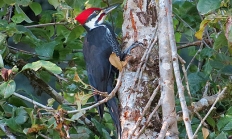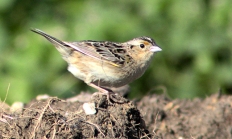Search myodfw.com
Commonly found along beaches and about estuaries, this large, ponderous bird is a conspicuous member of the summer coastal community, easily recognized by its large size, massive bill, and brownish plumage. Highly gregarious, it often forms large flocks; regularly observed foraging over the ocean just offshore. Brown pelicans often join mixed flocks of birds attracted to schools of small fish. They are common spring, summer, and fall visitors along the Oregon coast. Brown pelicans are an Oregon Conservation Strategy Species in the Nearshore ecoregion. Hear the call of the brown pelican Photo by Michael Lazott

The song of this bird is one of the characteristic sounds of spring evenings in much of the high desert country of eastern Oregon. This temperate migrant is a ground-nesting, ground-foraging bird of most of the grassland, agricultural land, and shrubs steppe habitats of Oregon. The streaked brownish plumage of the Vesper sparrow is similar to that of several small to medium-sized sparrows, except for white outer tail feathers, shown most conspicuously in flight. The Oregon vesper sparrow is an Oregon Conservation Strategy Species in the Klamath Mountains and Willamette Valley ecoregions. Hear the song of the Vesper sparrow Photo

The hoary bat has a wingspan of nearly 16 inches. It has dark fur tipped with white, a dark mask on its face, a yellow-orange throat and round ears edged in black. This bat roosts in branches of trees and likes to feed around outdoor lights. Hoary bats migrate south in winter, returning to Oregon in the spring. This bat usually bears twins. Hoary bats are found at scattered localities over most of the region west of the Cascade Range and in montane regions east of the Cascade Range. They are an Oregon Conservation Strategy Species in all ecoregions except

The Black oystercatcher is easily recognized with its black plumage, long, strait, laterally compressed, orange-red bill with a yellow tip, orange-red eye ring, yellow iris, and pale pink legs. These birds are restricted to rocky coastal shorelines where they feed in the intertidal zone. They are an uncommon to fairly common resident on rocky shores and sand/gravel beaches along the entire coast. Along the sandy central coast, they are present only as an occasional dispersing or wandering individual, typically on jetties. Black oystercatchers are Oregon Conservation Strategy Species in the Nearshore ecoregion. Hear the call of the Black oystercatcher Photo

Insects swept up in a rising air mass are favorite prey of this species nicknamed the "cloud swift." It prefers to nest near or even behind the curtain of a waterfall. This dark swift glides for long distances, often very high in the sky, with its wings held somewhat downward. It is larger and darker than the more common Vaux's swift, and has a slightly forked tail. The Black swift is a rare to uncommon spring and fall transient and summer visitant throughout the state. It's an Oregon Conservation Strategy Species in the West Cascades ecoregion. Hear the call of

The White-headed woodpecker is the only woodpecker that relies heavily on the seeds of ponderosa pine for food. It occurs mainly in open ponderosa pine or mixed conifer forests dominated by ponderosa pine. They usually excavate nest cavities in snags but may use stumps, leaning logs and dead tops of live trees. It is an uncommon permanent resident in forests of the Ochoco, Blue, and Wallowa mountains and the east side of the Cascades, but suitable habitat is restricted. The White-headed woodpecker is an Oregon Conservation Strategy Species in the Blue Mountains, East Cascades, and Klamath Mountains ecoregions. Hear the

Columbian sharp-tailed grouse, commonly called "prairie chickens" by early Oregon residents, were abundant in the grasslands and foothills of Oregon east of the Cascade Mountains prior to the late 1800s but were considered extirpated from the state by the 1970s. Recent reintroduction programs give a glimmer of hope that sharp-tails may once again hold their own in northeast Oregon. Males congregate on leks or dancing grounds in the spring and perform elaborate social displays. The Columbian sharp-tailed grouse is an Oregon Conservation Strategy Species in the Blue Mountains ecoregion. Hear the call of the Columbian sharp-tailed grouse Photo by Mike

The Chipping sparrow is a small and slender sparrow that has a distinctive sharp chip note and simple, trilling song. Breeding adults display a chestnut crown, a black eye-stripe, and crisp white eyebrow. After nesting season, both male and female lose their distinctive bright cap for a streaky dull brown head pattern that is similar to other winter sparrows. It is a common summer resident in open forests and drier woodland edges throughout Oregon and is especially abundant in the Blue Mountains. The Chipping sparrow is an Oregon Conservation Strategy Species in the Willamette Valley ecoregion. Hear the song of

These small salamanders have solid green- brown- or gray-colored sides and backs with bright yellow or orange undersides. Adults can grow to four inches in total length. Columbia torrent salamanders spend their lives in and near cold and clear water bodies including mountain streams, springheads, waterfalls and seeps in older forests. They need loose gravel stream beds for hiding and foraging. They are highly connected to their water sources, but in times of heavy rainfall, they may venture into a nearby forest. The Columbia torrent salamander is an Oregon Conservation Strategy Species in the Coast Range and Willamette Valley ecoregions


Western painted turtles need marshy ponds, small lakes, slow-moving streams and quiet, off-channel portions of rivers. They prefer waters with muddy bottoms with aquatic vegetation. Open ground for nesting and logs for basking help keep this species healthy. These painted turtles occur in the Blue Mountains and Willamette Valley ecoregions. In the Columbia Plateau, East Cascades and West Cascades ecoregions, they live only along the Columbia River. Western painted turtles are an Oregon Conservation Strategy Species in these: Blue Mountains, Coast Range, Columbia Plateau, East Cascades, West Cascades, Willamette Valley. Photo by Robert Bryce Ott

The Sierra Nevada red fox is a montane red fox subspecies. Its presence in Oregon was confirmed in 2015, specifically in the Mt. Jefferson, Mt. Washington, and Three Sisters Wilderness Areas. The Sierra Nevada red fox is smaller than the red fox and averages about eight pounds. This fox has three color phases: silver (black), "cross" color phase and the more familiar red. The Sierra Nevada red fox is an Oregon Conservation Strategy Species in the East Cascades, Klamath Mountains and West Cascades ecoregions. Research continues on this species in the Oregon Cascades. Biologists captured and radio-collared several Sierra Nevada

One of Oregon's rarest breeders, this distinctive "shorebird" is known for its courtship display flight and loud curlew-like call. it often perches in pine trees or on fence posts adjacent to nesting areas. A small plover-like head and short, strait bill seem out of proportion to its body, which is reminiscent of a small curlew. The Upland sandpiper is a rare breeder in large montane meadows within forests of eastern Oregon. They are almost never observed away form the breeding grounds in Oregon. The Upland sandpiper is an Oregon Conservation Strategy Species in the Blue Mountains ecoregion. Hear the call

The Lewis's woodpecker was named for Meriwether Lewis, who first described the species in 1805. This medium-sizesd vaguely crow-like woodpecker relies on flycatching during the spring and summer and store mast in the fall and winter. Formerly widespread in Oregon, it is currently common year-round only in the white oak-ponderosa pine belt east of Mt. Hood. It also breeds in low numbers in open habitat along east Oregon river and stream valleys. The Lewis's woodpecker is an Oregon Conservation Strategy Species in these ecoregions: Blue Mountains, Columbia Plateau, East Cascades, Klamath Mountains, West Cascades. Hear the call of the Lewis's

The Pileated woodpecker was the model for the cartoon character, Woody Woodpecker. It is a large black-and-white bird with a bold red feathered crest and distinctive call. You may hear its powerful drumming before you see it. In Oregon, its habitat includes older forests in the Blue Mountains, East and West Cascades, Klamath Mountains, Willamette Valley and Coast Range ecoregions. They prefer mature forests and younger forests with large snags and logs, requiring large diameter snags for nesting and foraging. Pileated woodpeckers are an Oregon Conservation Strategy Species in the Blue Mountains ecoregion. Hear the call and the drumming of

This striking songbird is best known for its habit of impaling prey on thorns and barbed wire, or wedging items in a v-shaped branch for easier handling and storage. The Loggerhead shrike breeds in open habitats east of the Cascades where they are rare but regular in the winter, especially at low-elevation sites. They are uncommon and declining in northeast Oregon. West of the Cascades, there are usually a few records each year during fall, winter, and spring in open habitats of the coast and the Willamette, Umpqua, and Rogue valleys. The Loggerhead shrike is an Oregon Conservation Strategy Species

The rat-sized American pika is characterized by rounded ears, no external tail, bare planter pads, and hind feed scarcely longer than the front feet. The pika requires talus, creviced rock, and other high elevation microhabitats that provide cool microclimates. Adequate forage close to rocky crevices is needed. In Oregon, the species is limited to suitable habitats in the Cascade Range and the Wallowa, Blue, Strawberry, Steens, Hart, and Warner mountains, and at Newberry Crater in Deschutes County and Grizzly and Cougar peaks in western Lake County. The American pika is an Oregon Conservation Strategy Species and is limited by its

The Grasshopper sparrow is one of the more enigmatic and erratic birds in Oregon. A small population may appear in an area, persist for a few years, and then disappear, only to return at some later time. It is difficult to detect, because of both its quiet, insect-like song and its reclusive habits. Males sing from elevated perches, such as flower stalks or fence posts before diving back among the grasses. It occurs in scattered "colonies" along the unforested northern slopes of the Blue Mountains. The Grasshopper sparrow is an Oregon Conservation Strategy Species in the Columbia Plateau, Klamath Mountains

Oregon has 15 species of bats, and eight of those are Oregon Conservation Strategy Species. Strategy Species are those having small or declining populations, are at-risk, and/or of management concern. Bats are flying mammals that can reach speeds of 20 to 30 mph. Some of Oregon's species migrate south in winter while some remain here and hibernate. Bats have ecolocation which allows them to make high-pitched sounds then listen to the echo of those sounds to locate where objects are. Echolocation helps them find even the smallest insect. Learn more about Oregon's bats on our Living with Wildlife, Bats page

The Washington ground squirrel is the smaller of the two short-tailed, spotted ground squirrels in Oregon. The dorsum has squarish grayish-white spots on a background of pale smoky-gray with a pinkish wash to brownish gray. This squirrel is endemic to the Deschutes-Columbia Plateau Province east and south of the Columbia River and east of the John Day River. A colonial species, it emerges from dormancy in January to early March, males before females. At the approach of a potential threat, the Washington ground squirrel produces a soft, lisping whistle. Other members of the colony respond by standing upright, repeating the

